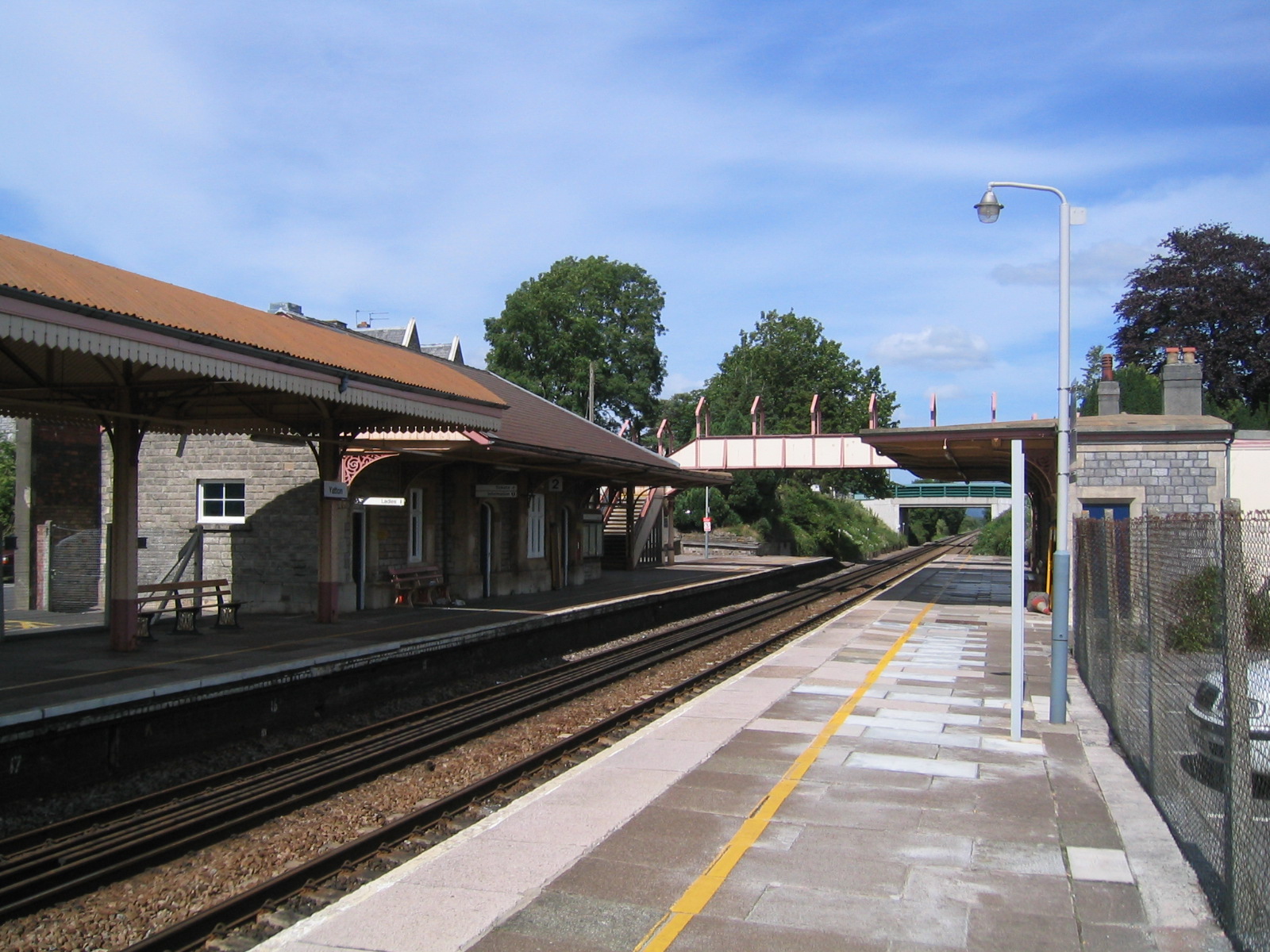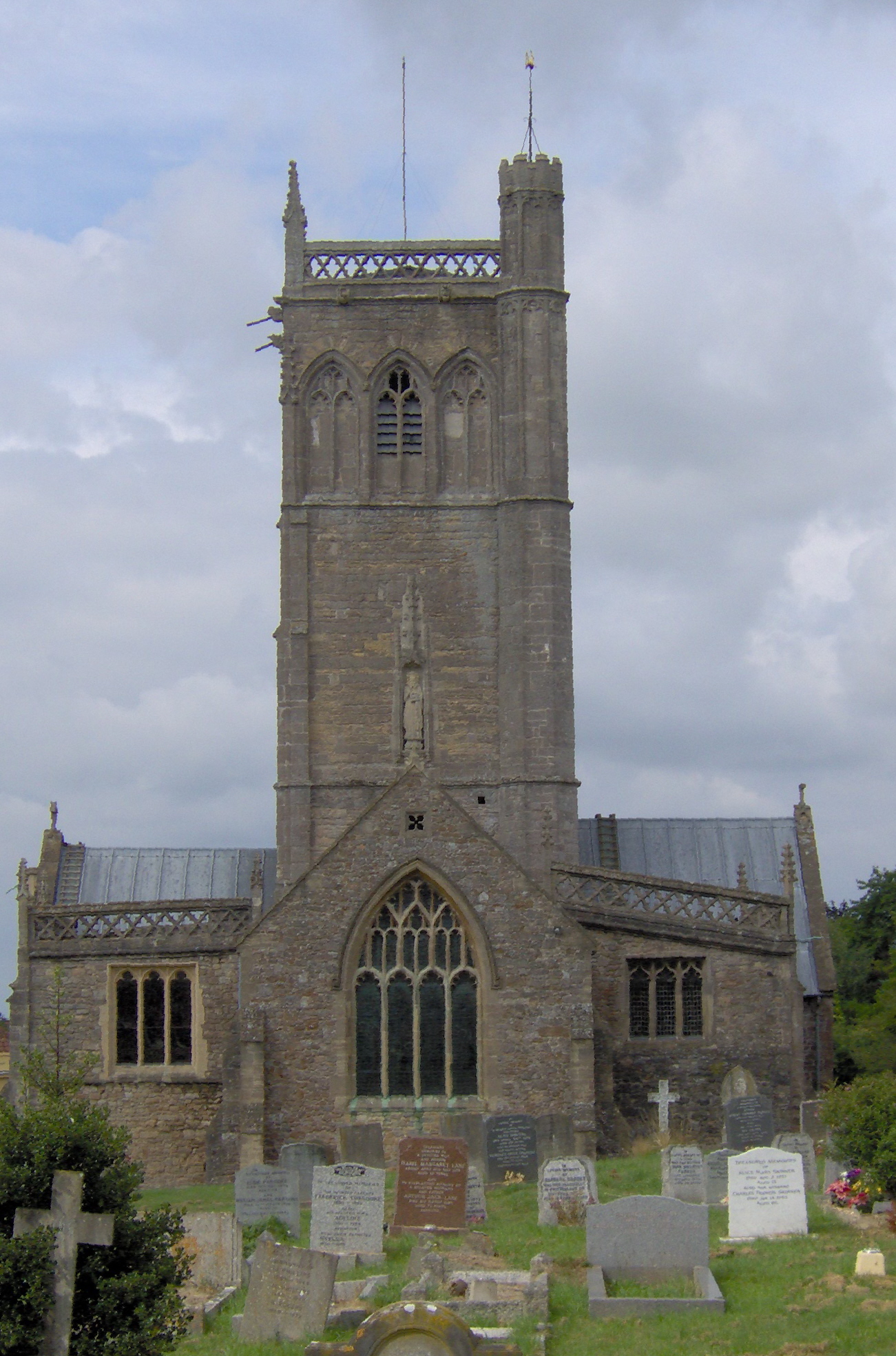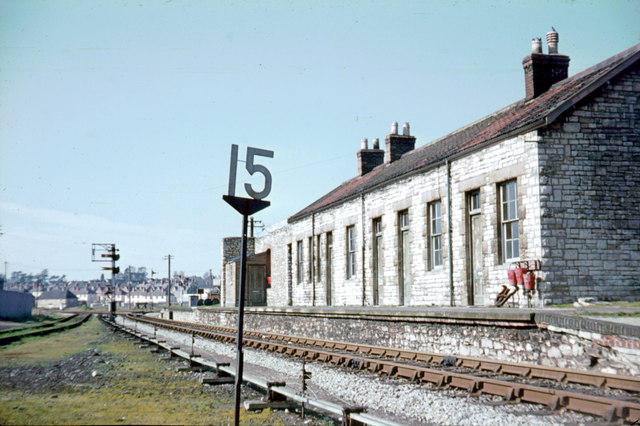|
Yatton Railway Station
Yatton railway station, on the Bristol to Exeter line, is in the village of Yatton in North Somerset, England. It is west of Bristol Temple Meads railway station, and from London Paddington. Its three-letter station code is YAT. It was opened in 1841 by the Bristol and Exeter Railway, and served as a junction station for trains to Clevedon and Cheddar, but these lines closed in the 1960s. The station, which has two platforms, is managed by Great Western Railway, the seventh company to be responsible for the station, and the third franchise since privatisation in 1997. They provide all train services at the station, mainly hourly services between and , and between and . The line is not currently electrified, and there is local support for electrification as an extension of the Great Western Main Line upgrade programme. A community centre and café was opened at the station in 2011. Description The station is located in the north end of the village of Yatton, North Somers ... [...More Info...] [...Related Items...] OR: [Wikipedia] [Google] [Baidu] |
Yatton
Yatton is a village and civil parish within the unitary authority of North Somerset, which falls within the ceremonial county of Somerset, England. It is located south-west of Bristol. Its population in 2011 was 7,552. The parish includes Claverham, a small village which was originally a farming hamlet. The origins of the village and its name are unclear; however, there is evidence of Iron Age hill fort and a Roman villa in the area. The arrival of the railway in the 19th century and more recent road building have led to expansion of the village with Yatton now acting as a home to many commuters, while also supporting manufacturing industry and commerce. The village is located on the North Somerset Levels, where the low-lying land, a mixture of peat, estuarine alluvium and low hills of sand and gravel, is crossed by a myriad of watercourses, providing a habitat for several scarce species. St Mary's Church dates from the 14th century and there are a range of other places of w ... [...More Info...] [...Related Items...] OR: [Wikipedia] [Google] [Baidu] |
Congresbury
Congresbury is a village and civil parish on the northwestern slopes of the Mendip Hills in North Somerset, England, which in 2011 had a population of 3,497. It lies on the A370 between Junction 21 of the M5 and Bristol Airport, south of Bristol city centre, and east of Weston-super-Mare. The Congresbury Yeo river flows through the village. The parish includes the hamlet of Brinsea. The nearest railway station is Yatton, with trains provided by Great Western Railway, but Congresbury once had its own railway station on the Cheddar Valley Line from Yatton to Wells. It was also the starting point for the Wrington Vale Light Railway, which went to nearby Wrington and Blagdon. History Congresbury is named after St Congar, who is said to have performed three miracles in the area. The second part of the name is thought to come from ''burh'' meaning fortified place. The remains of an Iron Age hill fort at Cadbury Hill have been discovered, as well as a Roman villa, temple and ... [...More Info...] [...Related Items...] OR: [Wikipedia] [Google] [Baidu] |
Diesel Multiple-unit
A diesel multiple unit or DMU is a multiple-unit train powered by on-board diesel engines. A DMU requires no separate locomotive, as the engines are incorporated into one or more of the carriages. Diesel-powered single-unit railcars are also generally classed as DMUs. Diesel-powered units may be further classified by their transmission type: diesel–mechanical DMMU, diesel–hydraulic DHMU, or diesel–electric DEMU. Design The diesel engine may be located above the frame in an engine bay or under the floor. Driving controls can be at both ends, on one end, or in a separate car. Types by transmission DMUs are usually classified by the method of transmitting motive power to their wheels. Diesel–mechanical In a diesel–mechanical multiple unit (DMMU), the rotating energy of the engine is transmitted via a gearbox and driveshaft directly to the wheels of the train, like a car. The transmissions can be shifted manually by the driver, as in the great majority of first-gene ... [...More Info...] [...Related Items...] OR: [Wikipedia] [Google] [Baidu] |
Taunton Railway Station
Taunton railway station is a junction station on the route from London to Penzance, west of London Paddington station. It is situated in Taunton, Somerset, and is operated by Great Western Railway. The station is also served by CrossCountry trains and by the West Somerset Railway on special event days and by mainline steam excursions. History Originally opened on 1 July 1842 as part of the Bristol and Exeter Railway, Taunton was the terminus of the line until a new temporary terminus was opened on 1 May 1843 further west at Beambridge. Isambard Kingdom Brunel's original design was for a single-sided station with two platforms, each with their own buildings and train sheds, placed on the south side of the line. A hotel was built between them and the Grand Western Canal. Having both platforms on the town side of the line was meant to help passengers but was found to be problematic as the railway became busier, with each train having to cross the line used by trains in the ... [...More Info...] [...Related Items...] OR: [Wikipedia] [Google] [Baidu] |
Cardiff Central Railway Station
, symbol_location = gb , symbol = rail , image = Cardiff Central station (26526139271).jpg , caption = 1930s frontage of Cardiff Central station (northern entrance) , borough = Cardiff, City and County of Cardiff , country = Wales , coordinates = , grid_name = Grid reference , grid_position = , owned = Network Rail , manager = Transport for Wales Rail , platforms = 8 , code = CDF , classification = DfT category A , years = 19 June 1850 , events = Opened as ''Cardiff'' , years1 = 1896 , events1 = Enlarged , years2 = 1924 , events2 = Renamed ''Cardiff General'' , years3 = 1931–34 , events3 = Rebuilt , years4 = 1940 , events4 = Merged with Cardiff Riverside station , years5 = 1964 , events5 = Riverside platforms closed , years6 = 1973 , events6 = Renamed ''Cardiff Central'' , years7 = 2015-17 , events7 = Enlarged , mpassengers = , footnotes = Passenger statistics from the Office of Rail and Road , mapframe=yes , mapframe-zoom = 13 Cardiff Cen ... [...More Info...] [...Related Items...] OR: [Wikipedia] [Google] [Baidu] |
Axbridge
Axbridge is a small town in Somerset, England, in the Sedgemoor district on the River Axe, near the southern edge of the Mendip Hills. The town's population according to the 2011 census was 2,057. History ''Axanbrycg'' is suggested as the source of the name, meaning a bridge over the River Axe, in the early 9th century. Early inhabitants of the area almost certainly include the Romans (who are known to have mined lead on the top of the Mendips) and earlier still, prehistoric man, who lived in the local caves, and whose flint tools have been found on the slopes of the local hills. The history of Axbridge can be traced back to the reign of King Alfred when it was part of the Saxons' defence system for Wessex against the Vikings. In the Burghal Hidage, a list of ''burhs'' compiled in 910, it was listed as ''Axanbrycg''. A listing of Axbridge appears in the Domesday survey of 1086 as ', meaning 'axe bridge' from the Old English ' and '. It was part of the royal manor of Chedda ... [...More Info...] [...Related Items...] OR: [Wikipedia] [Google] [Baidu] |
Strawberry Line Railway Walk
The Cheddar Valley line was a railway line in Somerset, England, running between Yatton and Witham. It was opened in parts: the first section connecting Shepton Mallet to Witham, later extended to Wells, was built by the East Somerset Railway from 1858. Later the Bristol and Exeter Railway built their branch line from Yatton to Wells, but the two lines were prevented for a time from joining up. Eventually the gap was closed, and the line became a simple through line, operated by the Great Western Railway. The line became known as ''The Strawberry Line'' because of the volume of locally-grown strawberries that it carried. It closed in 1963. Sections of the former trackbed have been opened as the ''Strawberry Line Trail'', which runs from Yatton to Cheddar. The southern section operates as a heritage railway using the name East Somerset Railway. History Main line railways Important inland market towns suddenly found themselves at a huge disadvantage when trunk railways connected ... [...More Info...] [...Related Items...] OR: [Wikipedia] [Google] [Baidu] |
APCOA
APCOA Parking AG is Europe's longest-established full service parking management company.APCOA at Sovereign Publications It manages over 1,400,000 parking spaces across 13 countries, and employs approximately 4,500 people. It is headquartered at in . History In 1949, and |
Pay And Display
A pay and display machine is a type of ticket machine used for regulating parking in urban areas or in car parks. It relies on a customer purchasing a ticket from a machine and displaying the ticket on the dashboard, windscreen or passenger window of the vehicle. Details included on a printed ticket are generally the location and operator of the machine, expiry time, fee paid and time entered. Systems The first generation of pay and display machines in the United States was introduced in 1950 by Park-UR-Self, based in San Francisco, California. Park-Ur-Self has grown to become the leading manufacturer of pay and display machines in the United States and now goes by the name Ventek International. Pay and display Pay and display systems differ from road-side parking meters in that one machine can service multiple vehicle spaces, resulting in lower set up costs. In addition, this system theoretically prevents drivers from taking advantage of parking meters that have time rema ... [...More Info...] [...Related Items...] OR: [Wikipedia] [Google] [Baidu] |
Dot Matrix
A dot matrix is a 2-dimensional patterned array, used to represent characters, symbols and images. Most types of modern technology use dot matrices for display of information, including mobile phones, televisions, and printers. The system is also used in textiles with sewing, knitting and weaving. An alternate form of information display using lines and curves is known as a vector display, was used with early computing devices such as air traffic control radar displays and pen-based plotters but is no longer used. Electronic vector displays were typically monochrome only, and either leave the interiors of closed vector shapes unfilled, or perform slow, time-consuming and often non-uniform shape-filling, as on pen-based plotters. In printers, the dots are usually the darkened areas of the paper. In displays, the dots may light up, as in an LED, CRT, or plasma display, or darken, as in an LCD. Usage in computers Although the output of modern computers is generally all in the ... [...More Info...] [...Related Items...] OR: [Wikipedia] [Google] [Baidu] |
National Rail
National Rail (NR) is the trading name licensed for use by the Rail Delivery Group, an unincorporated association whose membership consists of the passenger train operating companies (TOCs) of England, Scotland, and Wales. The TOCs run the passenger services previously provided by the British Railways Board, from 1965 using the brand name British Rail. Northern Ireland, which is bordered by the Republic of Ireland, has a different system. National Rail services share a ticketing structure and inter-availability that generally do not extend to services which were not part of British Rail. National Rail and Network Rail ''National'' Rail should not be confused with ''Network'' Rail. National Rail is a brand used to promote passenger railway services, and providing some harmonisation for passengers in ticketing, while Network Rail is the organisation which owns and manages most of the fixed assets of the railway network, including tracks, stations and signals. The two gener ... [...More Info...] [...Related Items...] OR: [Wikipedia] [Google] [Baidu] |
Network Rail
Network Rail Limited is the owner (via its subsidiary Network Rail Infrastructure Limited, which was known as Railtrack plc before 2002) and infrastructure manager of most of the railway network in Great Britain. Network Rail is an "arm's length" public body of the Department for Transport with no shareholders, which reinvests its income in the railways. Network Rail's main customers are the private train operating companies (TOCs), responsible for passenger transport, and freight operating companies (FOCs), who provide train services on the infrastructure that the company owns and maintains. Since 1 September 2014, Network Rail has been classified as a "public sector body". To cope with fast-increasing passenger numbers, () Network Rail has been undertaking a £38 billion programme of upgrades to the network, including Crossrail, electrification of lines and upgrading Thameslink. In May 2021, the Government announced its intent to replace Network Rail in 2023 with a ne ... [...More Info...] [...Related Items...] OR: [Wikipedia] [Google] [Baidu] |









